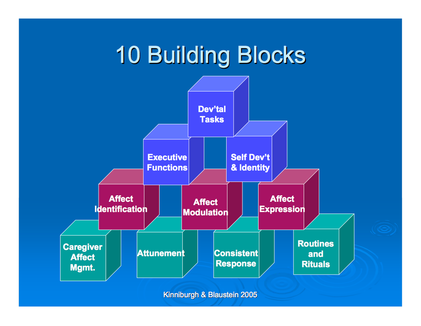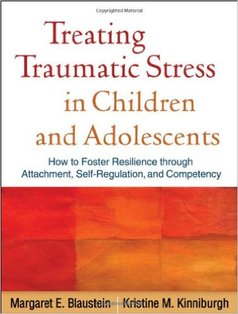Attachment, Self-Regulation, and Competency® (ARC) Model
ATTCH staff are thankful to have received training in the Attachment, Self-Regulation, and Competency (ARC) Model through the Trauma Centre at JRI (founded by Dr. Bessel van der Kolk). Our staff completed a 3-day training in the ARC model with Trauma Centre at JRI's Executive Director, Dr. Joseph Spinazolla and a 2-Day Training in the Sensory Motor Arousal Regulation Treatment (SMART) model with Dr. Elizabeth Warner. It was a fantastic training and one that we would highly recommend. Aspects of this training are covered off in a similar format through our core certification training: Day 1 Understanding the Foundations of Trauma and Attachment & Day 2 Phase-Based Clinical Applications to Promote Healing and Integration of Trauma and Attachment Dysregulation with Lori Gill, Founder and Lead Trauma Therapist, Attachment and Trauma Treatment Centre for Healing
Our founder and clinical director, Lori Gill, as well as our centre are listed on the 'find and ARC provider' website (providers can be sought out by city i.e., St. Davids, ON). You can search for a provider in your area using the following link: http://arcframework.org/for-parents-and-caregivers/parents-find-an-arc-provider/
The ARC model is an evidence based framework that aims to heal trauma wounds by raising awareness about trauma and its impact for children, professionals, and caregivers. There are 10 building blocks upon which the ARC framework are built upon (see image below). The ARC model is recommended by the American Academy of Paediatrics recommends the ARC model under their 'suggested therapies for the traumatized child' (p.13). Learn more about the ARC model and associated research findings on the Trauma Centre at JRI's website: http://www.traumacenter.org/research/ascot.php
Our founder and clinical director, Lori Gill, as well as our centre are listed on the 'find and ARC provider' website (providers can be sought out by city i.e., St. Davids, ON). You can search for a provider in your area using the following link: http://arcframework.org/for-parents-and-caregivers/parents-find-an-arc-provider/
The ARC model is an evidence based framework that aims to heal trauma wounds by raising awareness about trauma and its impact for children, professionals, and caregivers. There are 10 building blocks upon which the ARC framework are built upon (see image below). The ARC model is recommended by the American Academy of Paediatrics recommends the ARC model under their 'suggested therapies for the traumatized child' (p.13). Learn more about the ARC model and associated research findings on the Trauma Centre at JRI's website: http://www.traumacenter.org/research/ascot.php
Each of these building blocks are thoroughly expanded upon in the book by Blaustein & Kinniburgh: Treating Traumatic Stress in Children and Adolescents. This is a rich resource that offers a breadth of information to help professionals become adept at healing trauma and attachment dysregulation as well as worksheets to help children and youth better understand the impact trauma has at a neurological, physiological, and behavioural level and what they can do to become more empowered and create change.
I recently had a child I work with in residential treatment tell me that "my brain is broken" which was heartbreaking to hear but given my knowledge of neuroscioence I was able to reframe for him that, although his brain felt like it was broken our brain is actually quite brilliant in that it protects us when we experience overwhelming or terrifying events. I furthermore explained to him that as brilliant as our brain is, it sometimes become stuck perceiving that we remain in a state of danger even after the threat has passed and that we need to help it become unstuck through regulating our body and mind and changing the conscious messages we are sending ourselves. We proceeded to work through the handouts on 'false alarms' in the workbook which were quite reinforcing of the organic conversation that had come up that session. These tools help us to easily communicate the impact that trauma has and help us to form meaningful collaborative plans with children, youth, and their caregivers to reduce arousal, promote regulation, form meaning, and empower children, youth, and their caregivers to create sustainable changes.
I recently had a child I work with in residential treatment tell me that "my brain is broken" which was heartbreaking to hear but given my knowledge of neuroscioence I was able to reframe for him that, although his brain felt like it was broken our brain is actually quite brilliant in that it protects us when we experience overwhelming or terrifying events. I furthermore explained to him that as brilliant as our brain is, it sometimes become stuck perceiving that we remain in a state of danger even after the threat has passed and that we need to help it become unstuck through regulating our body and mind and changing the conscious messages we are sending ourselves. We proceeded to work through the handouts on 'false alarms' in the workbook which were quite reinforcing of the organic conversation that had come up that session. These tools help us to easily communicate the impact that trauma has and help us to form meaningful collaborative plans with children, youth, and their caregivers to reduce arousal, promote regulation, form meaning, and empower children, youth, and their caregivers to create sustainable changes.

